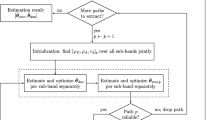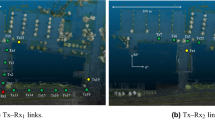Abstract
In this paper a time-domain technique for wideband fading depth evaluation, is proposed, which is applicable to both Line-of-Sight and Non-Line-of-Sight cases, and the probability functions of the wideband received power are derived, contributing for filling in the gap of short-term fading characterisation in wideband systems. Application examples for different systems, namely GSM, UMTS and HIPERLAN/2, working in different standard reference environments, are shown. As expected, it is observed that Rayleigh and Rice distributions are appropriate for evaluating the fading margins for GSM in some environments; nevertheless, for UMTS and HIPERLAN/2, fading margins are usually well below the ones obtained from considering these narrowband distributions, the differences reaching up to around 10 and 13 dB, respectively.
A simple relationship between the physical and the geometrical environment properties, and the rms delay spread of the propagation channel is also proposed, establishing a relationship between two models independently derived by different authors. Using the proposed relationship, fading depth results from the proposed time-domain technique are compared with the ones for an environment-geometry based one, and a good agreement is verified. The difference in fading depth between both approaches is roughly below 2 dB.
Similar content being viewed by others
References
H. Holma and A. Toskala, WCDMA for UMTS – Radio Access For Third Generation Mobile Communications, John Wiley: Chichester, UK, 2000.
M.D. Yacoub, Wireless Technology, Protocols Standards and Technology, CRC Press: Boca Raton, FL, USA, 2001.
L.M. Correia (ed.), Wireless Flexible Personalised Communications, John Wiley: Chichester, UK, 2001.
S. Kozono, “Received Signal-Level Characteristics in a Wide-Band Mobile Radio Channel”, IEEE Trans. Veh. Technol., Vol. 43, No. 3, pp. 480–486, Aug. 1994.
S. Kozono, S. Seino and H. Nakabayashi, “Received Signal-Level Characteristics of Wide-Band Transmission in Mobile Communications”, in Proc. of PIMRC'96–7th IEEE Int. Symp. on Personal, Indoor and Mobile Radio Commun., Taipei, Taiwan, Oct. 1996.
J. Yan and S. Kozono, “A Study of Received Signal-Level Distribution in Wideband Transmissions in Mobile Communications”, IEEE Trans. Veh. Technol., Vol. 48, No. 5, pp. 1718–1725, Sep. 1999.
H. Nakabayashi, J. Yian, H. Masui, M. Ishii, K. Sakawa, H. Shimizu, T. Kobayashi, and S. Kozono, “Validation of Equivalent Received Bandwidth to Characterize Received Signal Level Distribution Through Experiment and Simulation”, IEICE Trans. Commun., Vol. E84-B, No. 9, pp. 2250–2559, Sep. 2001.
F.D. Cardoso and L.M. Correia, “An Analytical Approach to Fading Depth Dependence on Bandwidth for Mobile Communication Systems”, in Proc. of WPMC'01 – 4th Int. Symp. on Wireless Personal Multimedia Commun., Aalborg, Denmark, Sep. 2001.
T. Inoue and Y. Karasawa, “Theoretical Analysis on the Level Variation Properties of Wideband Signals in the Rayleigh Fading Environment”, in Proc. of PIMRC'99 – 10th IEEE Int. Symp. on Personal, Indoor and Mobile Radio Commun., Osaka, Japan, Sep. 1999.
K. Pahlavan and A.H. Levesque, Wireless Information Networks, John Wiley: Chichester, UK 1995.
F.D. Cardoso, Short-Term Fading Characterisation in Wideband Mobile Communication Systems, Ph.D. Thesis, Instituto Superior Técnico, Technical University of Lisbon, Lisbon, Portugal, June 2004.
ETSI, Selection Procedures for the Choice of Radio Transmission Technologies of UMTS, Technical Report TR 101 112 v3.1.0, Sophia Antipolis, France, Nov. 1997.
3GPP, Deployment Aspects, TSG RAN WG4, Technical Report TR 25.943 v4.2.0, Sophia Antipolis, France, June 2002.
J. Medbo and P. Schramm, Channel Models for HIPERLAN/2 in Different Indoor Scenarios, Technical Report EP BRAN 3ERI085B, ETSI, Sophia Antipolis, France, Mar. 1998.
F.D. Cardoso and L.M. Correia, “Fading Depth Dependence on System Bandwidth in Mobile Communications – An Analytical Approximation”, IEEE Trans. Veh. Technol., Vol. 52, No. 3, pp. 587–594, May 2003.
F.D. Cardoso and L.M. Correia, “A Comparison between Different Approaches for Fading Evaluation in Wideband Mobile Communications”, in Proc. of VTC'03 Spring – 57th IEEE Semiannual Vehicular Technology Conference, Jeju, Korea, Apr. 2003.
Author information
Authors and Affiliations
Additional information
Filipe D. Cardoso received the Licenciado, M.Sc. and Ph.D. degrees in Electrical and Computer Engineering from IST/Technical University of Lisbon in 1991, 1996 and 2004, respectively. Since 1994 he has been with the Department of Electrical Engineering of EST/Polytechnic Institute of Setúbal, Setúbal, Portugal, where he is an Adjunct Professor in the Telecommunications area. He is also a researcher at the Telecommunications Institute, Lisbon. He has been a member of COST 273 and IST/FLOWS European projects and is involved in the Network of Excellence in Wireless Communications (NEWCOM). He has authored papers in national and international conferences and journals, for which he has also served as a reviewer. His research interests include wireless/mobile channel characterisation and modelling and future Mobile Broadband Systems.
Luis M. Correia received the Ph.D. in electrical and computer engineering from IST/Technical University of Lisbon in 1991, where he is currently a professor in telecommunications, with a focus on wireless/mobile communications in the areas of channel characterisation, traffic, services, and cellular planning. He as acted as a consultant for Portuguese GSM operators and for the telecommunications regulator. Besides being responsible for research projects at the national level, he was or is part of various ones within European frameworks (RACE, ACTS, and IST). He participated in and was co-editor of the Final Report for COST 231, Chairman and editor of the Final Report for COST 259, and is currently Chairman of COST 273. He was and is responsible for the supervision of students at both the M.Sc. and Ph.D. levels. He has authored papers and communications in international journals and conferences, for which he has also served as a reviewer, has been a co-editor of a special issue of a journal on wireless broadband systems, and is currently the editor for Wireless Systems in the European Transactions on Telecommunications. He as served as evaluator and auditor in ACTS, ESPRIT and IST frameworks. He was Chairman of the Technical Program Committee of PIMRC 2002.
Rights and permissions
About this article
Cite this article
Cardoso, F.D., Correia, L.M. A Time-Domain Based Approach for Short-Term Fading Depth Evaluation in Wideband Mobile Communication Systems. Wireless Pers Commun 35, 365–381 (2005). https://doi.org/10.1007/s11277-005-7681-x
Issue Date:
DOI: https://doi.org/10.1007/s11277-005-7681-x




